Intel Xeon Bronze 3204 Benchmarks
For this exercise, we are using our legacy Linux-Bench scripts which help us see cross-platform “least common denominator” results we have been using for years as well as several results from our updated Linux-Bench2 scripts. Starting with our 2nd Generation Intel Xeon Scalable benchmarks, we are adding a number of our workload testing features to the mix as the next evolution of our platform.
At this point, our benchmarking sessions take days to run and we are generating well over a thousand data points. We are also running workloads for software companies that want to see how their software works on the latest hardware. As a result, this is a small sample of the data we are collecting and can share publicly. Our position is always that we are happy to provide some free data but we also have services to let companies run their own workloads in our lab, such as with our DemoEval service. What we do provide is an extremely controlled environment where we know every step is exactly the same and each run is done in a real-world data center, not a test bench.
We are going to show off a few results, and highlight a number of interesting data points in this article.
Python Linux 4.4.2 Kernel Compile Benchmark
This is one of the most requested benchmarks for STH over the past few years. The task was simple, we have a standard configuration file, the Linux 4.4.2 kernel from kernel.org, and make the standard auto-generated configuration utilizing every thread in the system. We are expressing results in terms of compiles per hour to make the results easier to read:
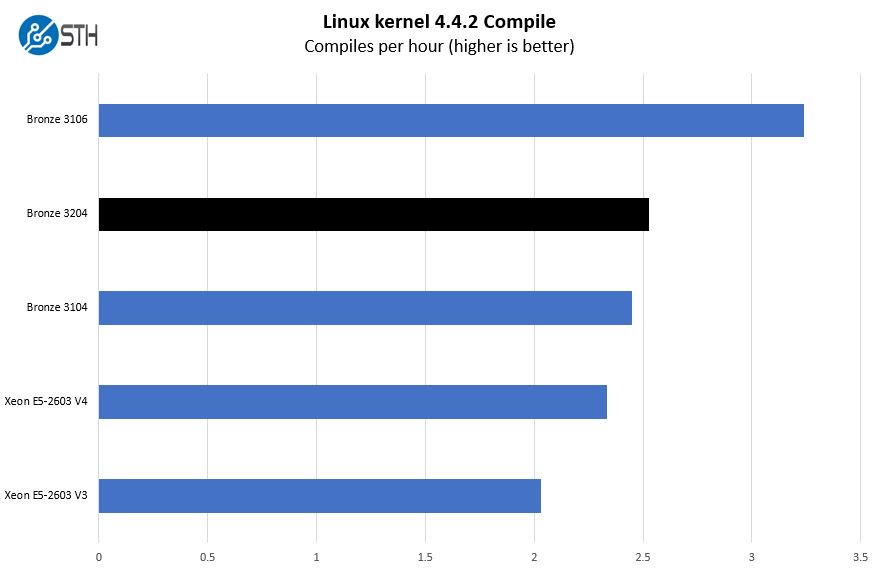
In this chart, one can see a minor but appreciable uptick in performance. For comparison purposes, we have the Intel Xeon E5-2603 V3, E5-2603 V4, and Intel Xeon Bronze 3104 CPUs here that represent five years of evolution in the $213 price segment. We also have the Intel Xeon Bronze 3106 which was another Intel Xeon Bronze part in the 2017 generation, but the model was dropped as part of SKU rationalization activities at Intel. That Intel Xeon Bronze 3106 was an eight-core part, but Intel effectively has said that if you want a “light the platform” part the Bronze 3204 is it while if you want any performance, get the Silver 4208 or higher.
c-ray 1.1 Performance
We have been using c-ray for our performance testing for years now. It is a ray tracing benchmark that is extremely popular to show differences in processors under multi-threaded workloads. We are going to use our 8K results which work well at this end of the performance spectrum.
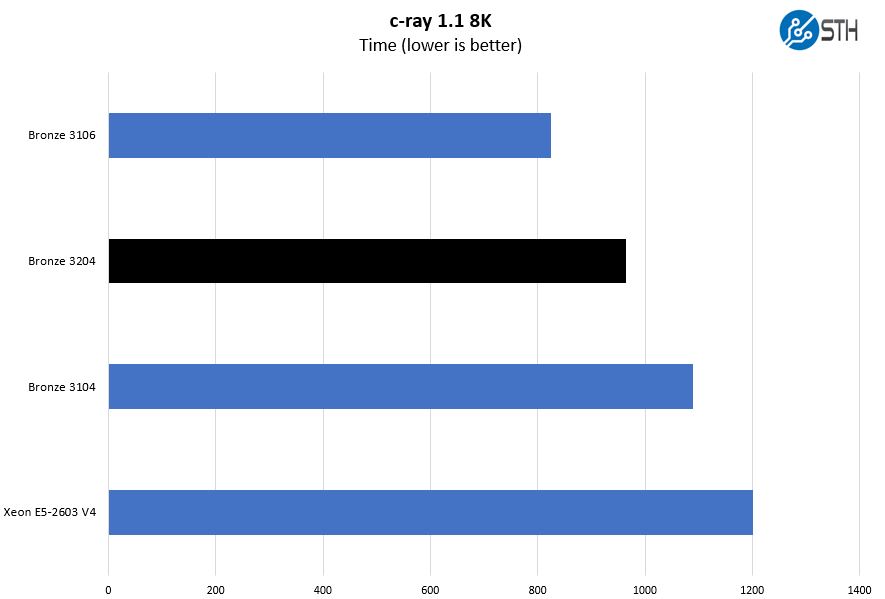
As a note here, we still used our 4K test in 2014 when the Intel Xeon E5-2603 V3 was launched so we do not have a number here. As a frame of reference, the lower-end Intel Xeon E-2136 is more than twice as fast here with Hyper-Threading and higher clock speeds.
7-zip Compression Performance
7-zip is a widely used compression/ decompression program that works cross-platform. We started using the program during our early days with Windows testing. It is now part of Linux-Bench.
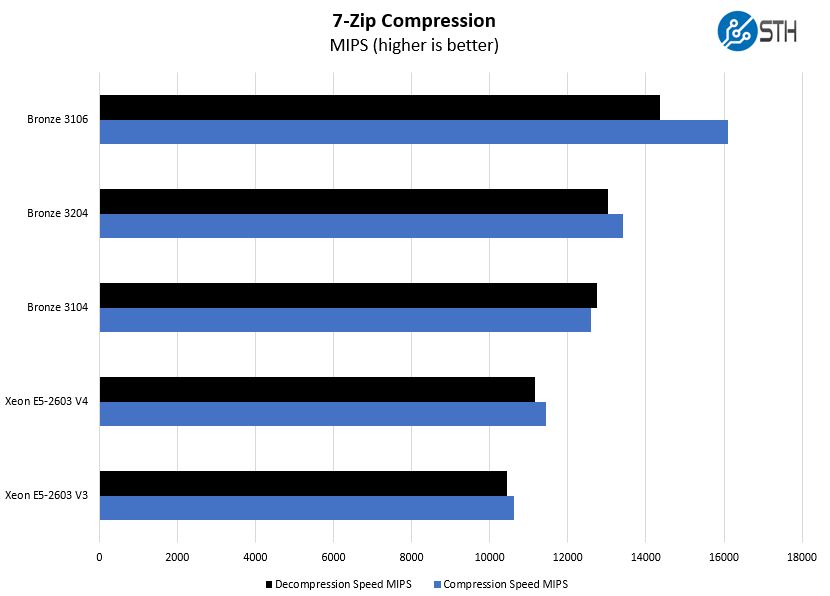
This is going to be a trend that we will see often. The Intel Xeon Bronze 3204 has a 200MHz bump over the Bronze 3104 which means everything is a bit faster, but not quite as fast as with a previous generation 8-core part.
NAMD Performance
NAMD is a molecular modeling benchmark developed by the Theoretical and Computational Biophysics Group in the Beckman Institute for Advanced Science and Technology at the University of Illinois at Urbana-Champaign. More information on the benchmark can be found here. We are going to augment this with GROMACS in the next-generation Linux-Bench in the near future. With GROMACS we have been working hard to support Intel’s Skylake AVX-512 and AVX2 supporting AMD Zen architecture. Here are the comparison results for the legacy data set:
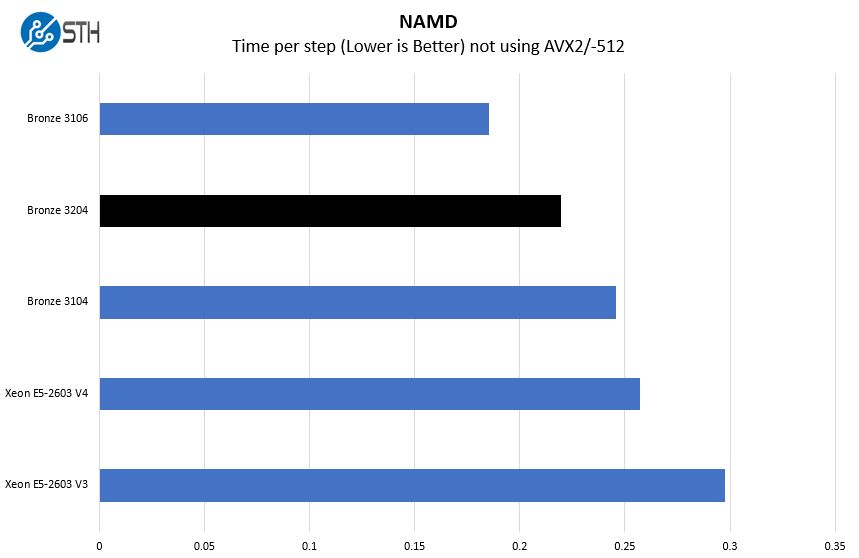
We actually saw a nice gain in this test. One can see the generational improvements over the past five years leading a steady progression.
Sysbench CPU test
Sysbench is another one of those widely used Linux benchmarks. We specifically are using the CPU test, not the OLTP test that we use for some storage testing.
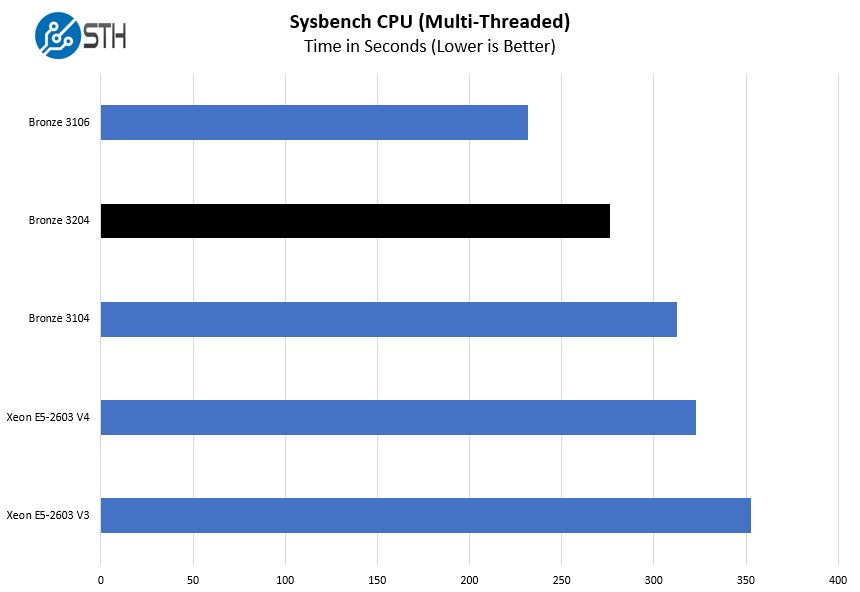
This is a similar pattern to what we have been seeing. We wanted to quickly also highlight the single threaded performance.
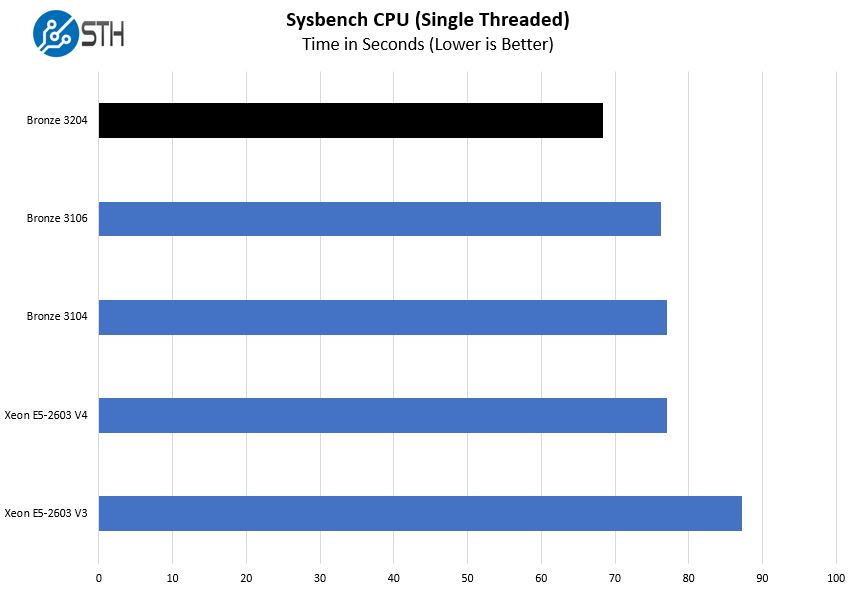
With a 1.9GHz clock speed, the Intel Xeon Bronze 3204 offers a modest improvement over previous generation chips stuck in the 1.6GHz – 1.7GHz range.
OpenSSL Performance
OpenSSL is widely used to secure communications between servers. This is an important protocol in many server stacks. We first look at our sign tests:
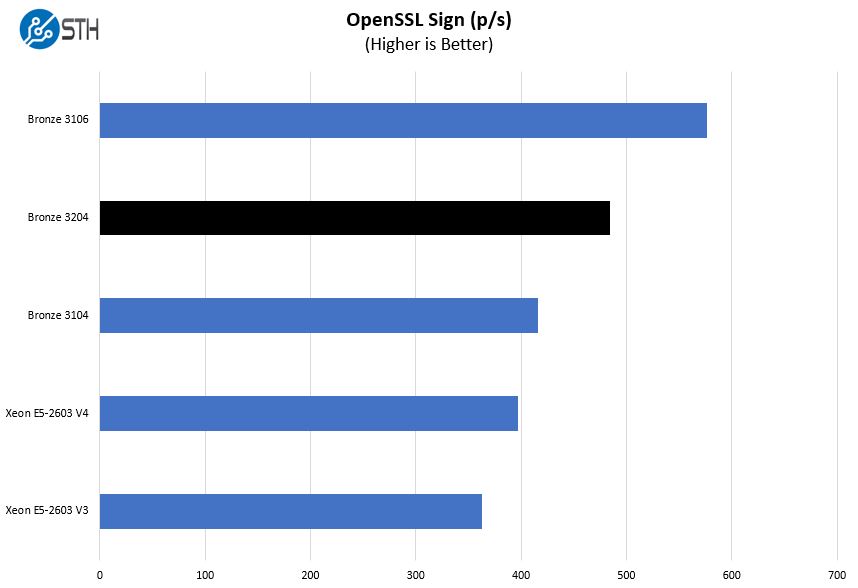
Here are the verify results:
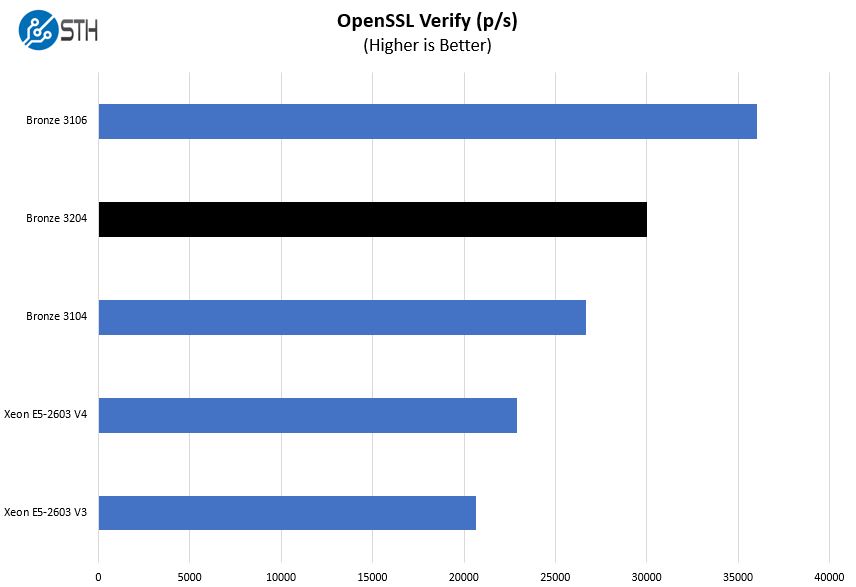
This is another result where we got a performance improvement that was perhaps slightly more than we would have expected but in line with an 11-12% clock speed boost.
UnixBench Dhrystone 2 and Whetstone Benchmarks
Some of the longest-running tests at STH are the venerable UnixBench 5.1.3 Dhrystone 2 and Whetstone results. They are certainly aging, however, we constantly get requests for them, and many angry notes when we leave them out. UnixBench is widely used so we are including it in this data set. Here are the Dhrystone 2 results:
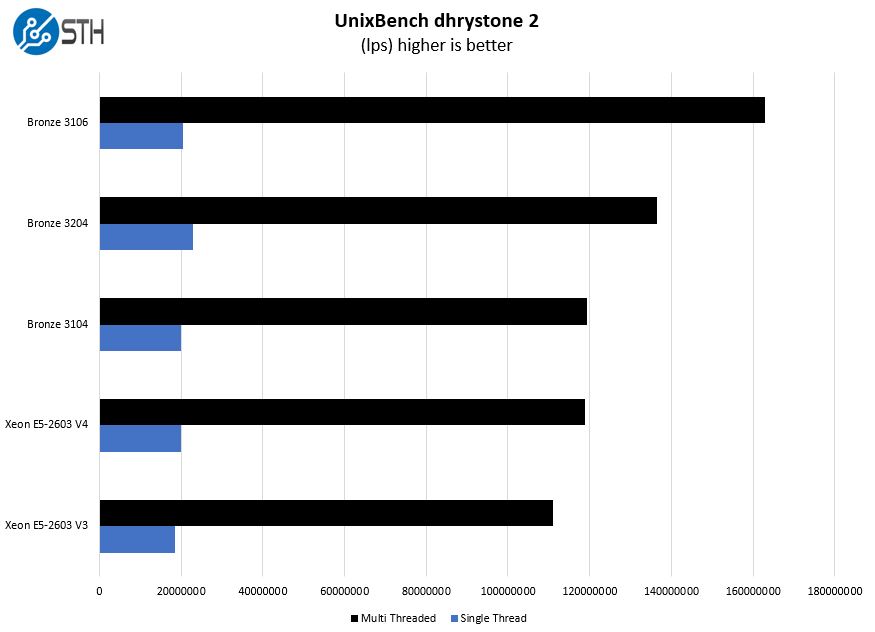
Here are the whetstone results:
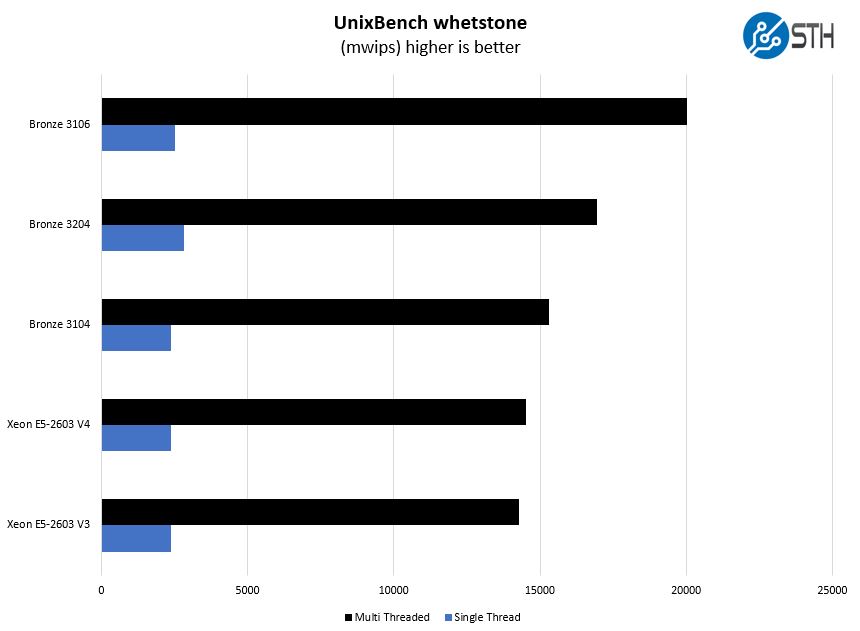
Here one can clearly see the impact of the clock speed bump. It is the fastest single-threaded chip in this $213 segment both in single and multi-threaded workloads.
GROMACS STH Medium AVX2/ AVX-512 Enabled
We have a small GROMACS molecule simulation we previewed in the first AMD EPYC 7601 Linux benchmarks piece. In Linux-Bench2 we are using our “small” case which is appropriate for single-socket servers. Our GROMACS test will use the AVX-512 and AVX2 extensions if available.
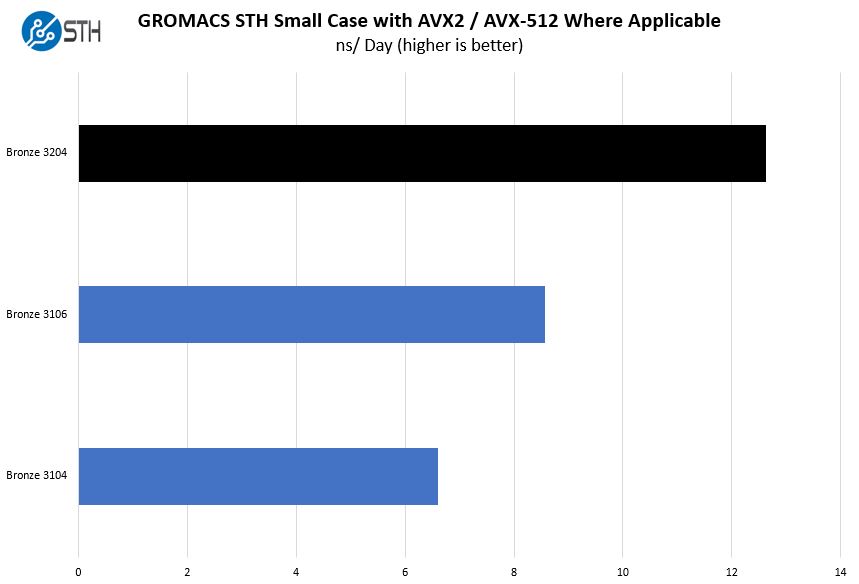
We wanted to focus on the Intel Xeon Bronze CPUs here to show something that we are seeing consistently across the Bronze, Silver, and Gold 5200 series SKUs thus far. Our GROMACS STH Small Case performance is gone up significantly. We use containers to keep all variables the same. We even pulled the Bronze 3204 and put in Bronze 3104 and Bronze 3106 CPUs in the same system, and we are getting similar results.
We noted in our 2nd Gen Intel Xeon Scalable Launch Details and Analysis piece’s initial benchmarking that the dual Intel Xeon Gold 5220 series was performing much better in the same test than the previous generation Intel Xeon Gold 5100 series. These lower-end chips that are supposed to have lower-end AVX-512 seem to have performance more akin to what we see in dual port FMA AVX-512 parts. Here is an idea of what we saw in the previous version where you can see that the Intel Xeon Gold 6132 14-core part is massively faster than the 14 core Intel Xeon Gold 5119T, more than the clock speed delta would suggest. Here is a chart from our Intel Xeon Gold 5117 review.
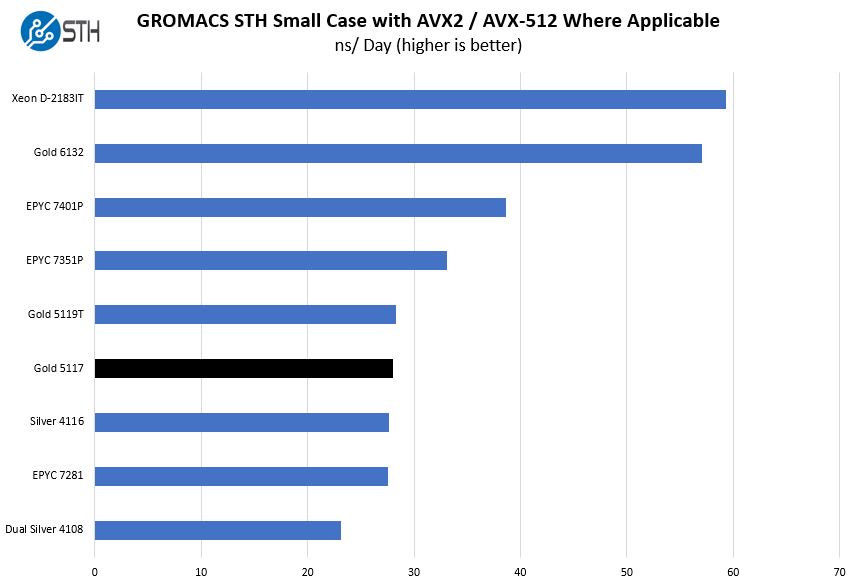
We also saw the Intel Xeon D-2100 series in our Intel Xeon D-2183IT Benchmarks and Review 16C SoC an AVX-512 Monster piece perform better than one would expect with single port FMA AVX-512. Our Editor-in-Chief, Patrick, confirmed with Intel at the launch event that the Gold 5200 series and below is still supposed to have single port FMA AVX-512.
Just to put a bit of perspective on this, the Intel Xeon Silver 4108 has a higher single threaded performance with Turbo Boost speeds of 3.0GHz, it has 8 cores and 16 threads versus the 6-core Intel Xeon Bronze 3204. It has more cache and higher memory clock rates using DDR4-2400 DRAM. When we put that on our chart with the Bronze SKUs, we see this picture:
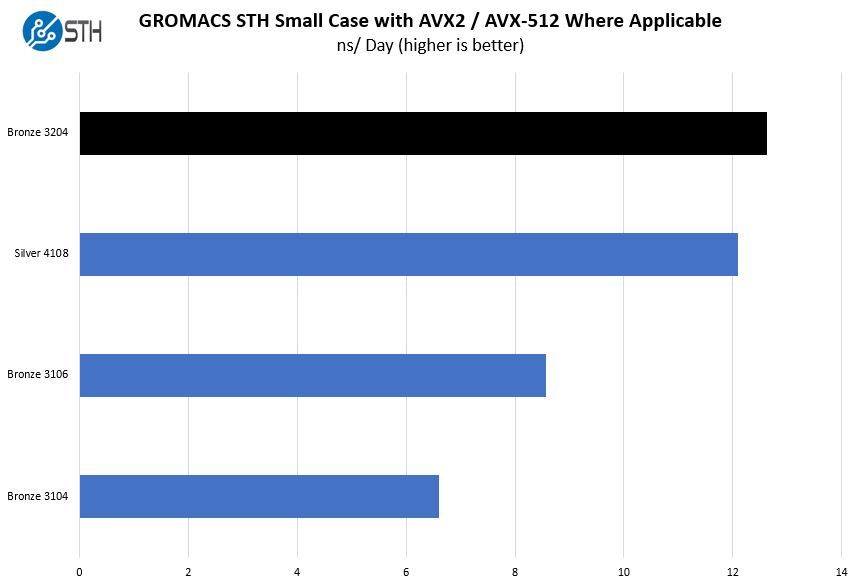
Higher clock speeds, more threads, higher DDR4 speeds and one can easily explain potential reasons we saw the Intel Xeon Silver 4108 outpace the Bronze 3106 and 3104 by a notable margin. They also make it hard to explain the Bronze 3204 result here unless something has changed with the AVX-512 units, which we have been told have not seen a significant change. The code and scripts are the exact same, the physical platform is the exact same, and we are not changing anything to take advantage of the new architecture. We even back-tested this using our older 57K GROMACS test environment we were using in September 2017 and the performance delta with the Bronze 3204 remained.
There is no reason a 200MHz or 11% clock speed increase, should yield a 91% performance increase for the Intel Xeon Bronze 3204 and older Bronze 3104 assuming everything else is really the same. Something is clearly going on here. Either there is a much better AVX-512 implementation in the Intel Xeon Bronze 3204 and other Silver/ Gold 5200 CPUs than in the previous generation, or something else is happening. We have data on several other SKUs already in the Silver/ Gold 5200 stack and there is a clear pattern. The Intel Xeon Gold 6200 and Platinum 8200 series SKUs did not exhibit a dramatic improvement like we are seeing in the lower-end parts. Instead, the Gold 6200 and Platinum 8200 perform as expected and in-line with the Gold 6100 and Platinum 8100 results on this test. This points to it not being an across the board architectural change and instead something happening with Intel Xeon Bronze, Silver, and Gold 5200 series parts in this generation.
Chess Benchmarking
Chess is an interesting use case since it has almost unlimited complexity. Over the years, we have received a number of requests to bring back chess benchmarking. We have been profiling systems and now use the results in our mainstream reviews:
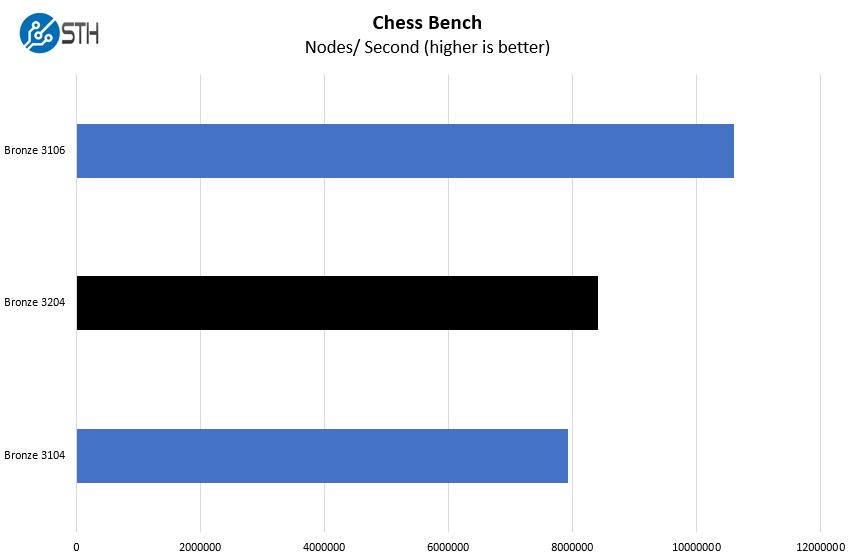
To put another view of how outsized our GROMACS delta is, here is the chess benchmark that shows what we would expect from an approximately 11% clock speed increase.
The vast majority of these numbers show a relatively minor improvement. The AVX-512 enabled benchmark is clearly an outlier and we have seen it with several Gold 5200 series CPUs we have already tested as well.
Next, we are going to discuss market positioning before our final words.




I bought a pair of 3104 for less than $500 and put on an new exotic Supermicro board. This was our first dual CPU attempt. We figured if happy we replace with a pair of Silvers for $1500 to $2500 the pair. Well the performance from the 3104 pair is so good we have not done that. That is besides the ability to use everything instead of restrictions on one CPU boards. I figure the same for a 3204 pair. I agree a single 3204 is useless.
We are now looking to put in another Supermicro dual CPU board but want to take advantage of the 2900 memory available but it seems to be only available on Gold class. What does Serve the home say about that?
That AVX-512 // GROMACS is fascinating. Sure looks more than 200MHz.
These are also good if you want a physical directory server and stuff like that if you’re got an org that doesn’t want to virtualize
Nice reviews, thanks for that!
Just one point: Instead of using GROMACS to judge AVX performance, why don’t you use Intels Linpack benchmark for that? Although I know GROMACS makes heavy use of AVX instructions, you just cannot say if there are two or just one FMA unit available. (Also with linpack you should not make any claims about it but as it is the one (and only) benchmark that can saturate the FMA units…but do not forget to measure ‘real’ frequencies at the same time e.g. with turbostat on llnux. ) Probably the most interesting benchmark would be to use Agner Fog’s tools:
https://www.agner.org/optimize/
He has the skills to really measure instruction throughput and stuff like that.
Personally I think a Linpack/DGEMM benchmark would be better than just using GROMACS to measure AVX performance.
And now intel tells us to turn HT off because of security issues (which makes these CPU’s atleast 25% slower).
RIDL and Fallout: MDS attacks, Attacks on the newly-disclosed “MDS” hardware vulnerabilities in Intel CPUs.
GROMACS works a lot faster on GPU’s, just check puget for performance metrics.
Any chance to do a proper power consumption test? TDP is not an accurate metric.
Our city has frequent blackouts, so we use custom UPS linked to car battery, (so that the machine can survive the blackout without shutdown) so lower wattage is always better for us.